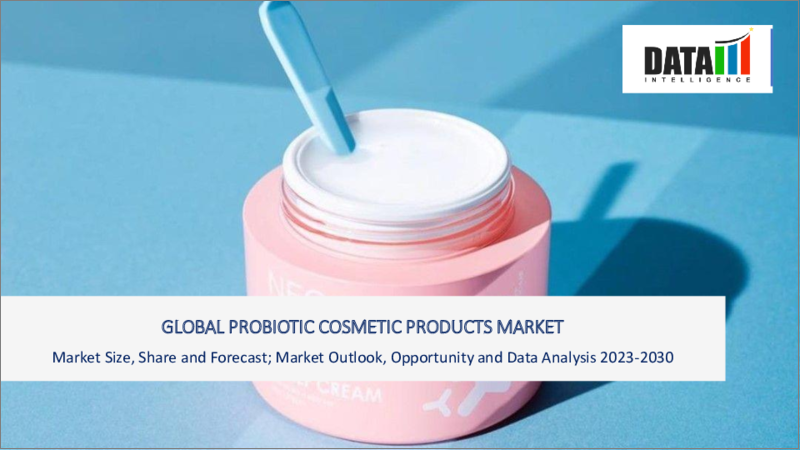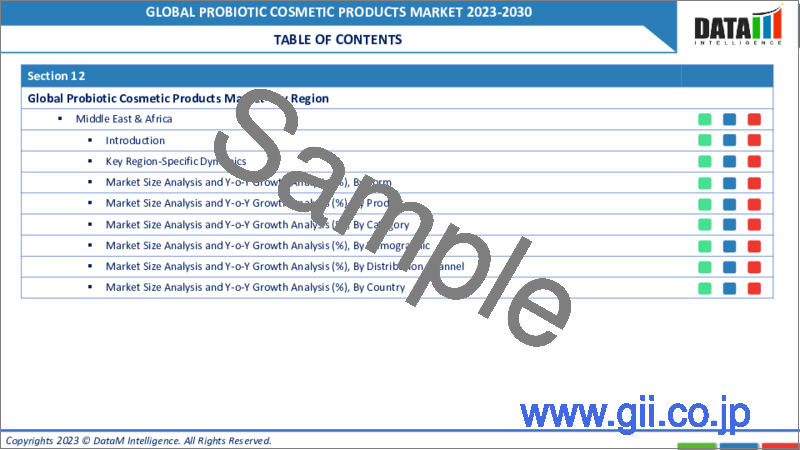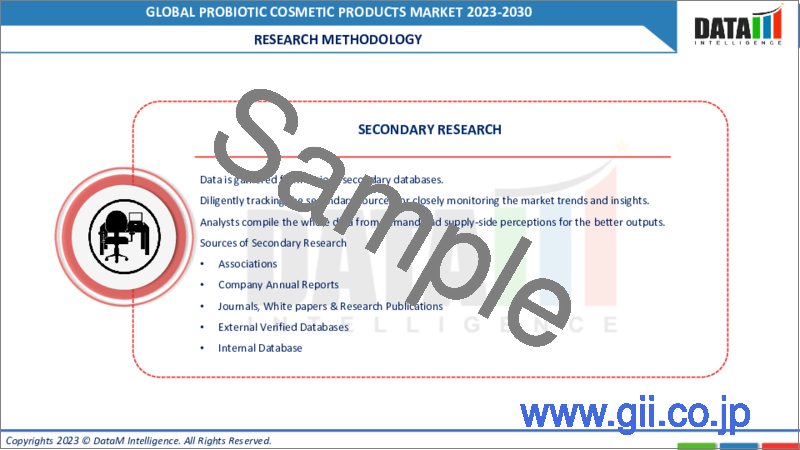|
|
市場調査レポート
商品コード
1290406
プロバイオティクス化粧品の世界市場-2023-2030Global Probiotic Cosmetic Products Market - 2023-2030 |
||||||
カスタマイズ可能
適宜更新あり
|
|||||||
| プロバイオティクス化粧品の世界市場-2023-2030 |
|
出版日: 2023年06月12日
発行: DataM Intelligence
ページ情報: 英文 118 Pages
納期: 即日から翌営業日
|
- 全表示
- 概要
- 目次
市場概要
プロバイオティクス化粧品の世界市場は、2022年に2億9,430万米ドルに達し、2030年には最大4億9,440万米ドルに達することで有利な成長を示すと予測されます。同市場は、予測期間2023-2030年に6.7%のCAGRで成長する見通しです。
プロバイオティクス化粧品の世界市場は、ナチュラルでオーガニックなスキンケアソリューションに対する消費者の関心の高まりに後押しされ、急速な成長を遂げています。プロバイオティクス化粧品市場は、プロバイオティクス・スキンケア製品に対する消費者の需要が堅調に推移していることから、今後数年間は成長が見込まれています。
プロバイオティクス化粧品市場には、クレンジング、美容液、モイスチャライザー、マスクなどの幅広い製品があり、老舗ブランドや新興の新興企業から発売されています。プロバイオティクス化粧品市場は競争が激しく、既存企業や新興企業が消費者の需要に応えるために革新的な製品を開発しています。
市場力学
ウェルネスとセルフケアへの動向が市場成長を牽引
消費者が健康志向を強め、セルフケアを優先するようになると、健康やウェルネスに役立つ製品を求めるようになります。プロバイオティクス化粧品は、内側から健康で輝く肌を実現する方法として認識されており、こうした製品の需要拡大に繋がっています。
プロバイオティクス化粧品の市場が拡大するにつれ、企業は研究開発に投資し、プロバイオティクス成分の革新的な配合やデリバリーシステムの開発に取り組んでいます。このため、クレンジングや美容液からモイスチャライザーやマスクに至るまで、さまざまな新製品が市場に参入しています。
美容業界におけるパーソナライゼーションとカスタマイズへの注目の高まりが、市場の成長を促進する
美容業界におけるパーソナライゼーションとカスタマイズへの注目の高まりが、プロバイオティクス化粧品市場の需要を牽引しています。消費者は個々のニーズや好みに合わせた製品を求めており、それがカスタマイズされたプロバイオティックスキンケアソリューションの開発につながっています。また、美容業界における持続可能性と環境配慮への注目の高まりも、プロバイオティクス化粧品市場の需要を促進しています。
COVID-19の影響分析
COVID-19パンデミックはサプライチェーンを混乱させ、景気減速はプロバイオティック化粧品市場に影響を与えました。パンデミックが市場に与える長期的な影響は、依然として不透明です。しかし、パンデミックによる実店舗や美容院の閉鎖は売上減少につながり、一方、個人の衛生管理やセルフケアへの関心の高まりは、プロバイオティクス化粧品を含むスキンケア製品の需要を押し上げました。
また、パンデミックに関連した規制によりオンライン販売にシフトしたことも市場に影響を与えており、各社はeコマース・プラットフォームに注力しています。
人工知能の影響分析
世界のプロバイオティック化粧品市場は、人工知能(AI)の利用が進むことで影響を受けています。AIは、製品開発、パーソナライズされたマーケティング、サプライチェーン管理の改善に活用されています。企業がカスタマイズされた製品を提供し、顧客エンゲージメントを強化するのに役立っています。AIの使用は今後増加し、市場の革新と成長の機会が増えると予想されます。
目次
第1章 調査手法とスコープ
- 調査手法
- 調査目的および調査範囲
第2章 定義と概要
第3章 エグゼクティブサマリー
第4章 市場力学
- 影響要因
- 促進要因
- 抑制要因
- 機会
- 影響分析
第5章 産業分析
- ポーターのファイブフォース分析
- サプライチェーン分析
- 価格分析
- 法規制の分析
第6章 COVID-19の分析
第7章 製品タイプ別
- スキンケア
- ヘアケア
- その他
第8章 エンドユーザー別
- 男性
- 女性
第9章 流通チャネル別
- スーパーマーケット、ハイパーマーケット
- eコマース
- コンビニエンスストア
- その他
第10章 地域別
- 北米
- 米国
- カナダ
- メキシコ
- 欧州
- ドイツ
- 英国
- フランス
- イタリア
- スペイン
- その他欧州
- 南米
- ブラジル
- アルゼンチン
- その他南米地域
- アジア太平洋地域
- 中国
- インド
- 日本
- オーストラリア
- その他アジア太平洋地域
- 中東・アフリカ地域
第11章 競合情勢
- 競合シナリオ
- 市況ポジショニング/シェア分析
- M&A(合併・買収)分析
第12章 企業プロファイル
- Unilever plc
- 会社概要
- 製品ポートフォリオと説明
- 財務概要
- 主な発展状況
- LaFlore Probiotic Skincare
- The Estee Lauder Companies Inc.
- The Clorox Co.
- Glowbiotics, Inc.
- Eminence Organic Skincare
- Tula Life, Inc.
- Esse Skincare
- Aurelia Skincare Ltd.
- L'oreal S.A.
第13章 付録
Market Overview
The Global Probiotic Cosmetic Products Market reached US$ 294.3 million in 2022 and is projected to witness lucrative growth by reaching up to US$ 494.4 million by 2030. The market is growing at a CAGR of 6.7% during the forecast period 2023-2030.
The Global Probiotic Cosmetic Products Market is experiencing rapid growth, driven by increasing consumer interest in natural and organic skincare solutions. The probiotic cosmetic products market is expected to grow in the coming years, as consumer demand for probiotic skincare products remains strong.
The probiotic cosmetic products market includes a wide range of products, such as cleansers, serums, moisturizers, and masks, available from established brands and emerging startups. The probiotic cosmetic products market is highly competitive, with established and emerging companies developing innovative products to meet consumer demand.
Market Dynamics
The Trend Toward Wellness and Self-Care Drives the Market Growth
As consumers become more health-conscious and prioritize self-care, they seek products offering health and wellness benefits. Probiotic cosmetic products are perceived as a way to achieve healthy and glowing skin from the inside out, and this has led to increasing demand for these products.
As the market for probiotic cosmetic products continues to grow, companies are investing in research and development to create innovative formulations and delivery systems for probiotic ingredients. This leads to a range of new products entering the market, from cleansers and serums to moisturizers and masks.
Increasing Focus on Personalization and Customization in the Beauty Industry Drives the Market Growth
The increasing focus on personalization and customization in the beauty industry is driving the demand for probiotic cosmetic products market. Consumers are seeking products tailored to their individual needs and preferences, which has led to the development of customized probiotic skincare solutions. The increasing focus on sustainability and eco-friendliness in the beauty industry is also driving the demand for probiotic cosmetic products market.
COVID-19 Impact Analysis
The COVID-19 pandemic disrupted supply chains and the economic slowdown have affected the probiotic cosmetic products market. The long-term impact of the pandemic on the market remains uncertain. However, the closure of physical stores and beauty salons during the pandemic has led to a decline in sales, while the increased focus on personal hygiene and self-care has boosted the demand for skincare products, including probiotic cosmetic products.
The shift towards online sales due to pandemic-related restrictions has also impacted the market, with companies focusing on e-commerce platforms.
Artificial Intelligence Impact Analysis
The global probiotic cosmetic products market is being impacted by the increasing use of artificial intelligence (AI). AI is being used to improve product development, personalized marketing, and supply chain management. It is helping companies to offer customized products and enhance customer engagement. The use of AI is expected to increase in the future, offering more opportunities for innovation and growth in the market.
Segment Analysis
The Global Probiotic Cosmetic Products Market is segmented based on product type, end-user, distribution channel, and region.
The Women Segment has Been the Largest Contributor to the Growth of the Global Probiotic Cosmetic Products Market
The increasing prevalence of skin-related issues such as acne, eczema, and rosacea among women has also contributed to the growth of this segment. The rising awareness of the benefits of probiotics for skin health and the demand for anti-aging products have further fueled the growth of this segment. Moreover, the availability of a wide range of probiotic cosmetic products specifically designed for women, including cleansers, moisturizers, serums, and masks, has also contributed to the growth of the market.
Geographical Analysis
Strong Presence of Vendors of Probiotic Cosmetic Products Market in North America
The North American market has dominated the Global Probiotic Cosmetic Products market. There is a high demand for natural and organic skincare products in this region, which has driven the market's growth. Additionally, the region has a strong presence of key players in the beauty industry who have been actively introducing new probiotic-based skincare products to meet the growing consumer demand.
Competitive Landscape
The major Global Probiotic Cosmetic Products Market players include: Unilever plc, LaFlore Probiotic Skincare, The Estee Lauder Companies Inc., The Clorox Co., Glowbiotics, Inc., Eminence Organic Skincare, Tula Life, Inc., Esse Skincare, Aurelia Skincare Ltd. and L'oreal S.A.
Why Purchase the Report?
- To visualize the global probiotic cosmetic products market segmentation based on product type, end-user, distribution channel, and region and understand key commercial assets and players.
- Identify commercial opportunities by analyzing trends and co-development.
- Excel data sheet with numerous probiotic cosmetic products market-level data points with all segments.
- PDF report consists of a comprehensive analysis after exhaustive qualitative interviews and an in-depth study.
- Product mapping available as Excel consisting of key products of all the major players.
The Global Probiotic Cosmetic Products Market Report Would Provide Approximately 61 Tables, 57 Figures, And 118 pages.
Target Audience 2023
- Manufacturers/ Buyers
- Industry Investors/Investment Bankers
- Research Professionals
- Emerging Companies
Table of Contents
1. Methodology and Scope
- 1.1. Research Methodology
- 1.2. Research Objective and Scope of the Report
2. Definition and Overview
3. Executive Summary
- 3.1. Snippet by Product Type
- 3.2. Snippet by End-User
- 3.3. Snippet by Distribution Channel
- 3.4. Snippet by Region
4. Dynamics
- 4.1. Impacting Factors
- 4.1.1. Drivers
- 4.1.2. Restraints
- 4.1.3. Opportunity
- 4.1.4. Impact Analysis
5. Industry Analysis
- 5.1. Porter's Five Forces Analysis
- 5.2. Supply Chain Analysis
- 5.3. Pricing Analysis
- 5.4. Regulatory Analysis
6. COVID-19 Analysis
- 6.1. Analysis of COVID-19
- 6.1.1. Before COVID-19 Scenario
- 6.1.2. Present COVID-19 Scenario
- 6.1.3. Post COVID-19 or Future Scenario
- 6.2. Pricing Dynamics Amid COVID-19
- 6.3. Demand-Supply Spectrum
- 6.4. Government Initiatives Related to the Market During Pandemic
- 6.5. Manufacturers Strategic Initiatives
- 6.6. Conclusion
7. By Product Type
- 7.1. Introduction
- 7.1.1. Market Size Analysis and Y-o-Y Growth Analysis (%), By Product Type
- 7.1.2. Market Attractiveness Index, By Product Type
- 7.2. Skin Care*
- 7.2.1. Introduction
- 7.2.2. Market Size Analysis and Y-o-Y Growth Analysis (%)
- 7.3. Hair Care
- 7.4. Others
8. By End-User
- 8.1. Introduction
- 8.1.1. Market Size Analysis and Y-o-Y Growth Analysis (%), By End-User
- 8.1.2. Market Attractiveness Index, By End-User
- 8.2. Men*
- 8.2.1. Introduction
- 8.2.2. Market Size Analysis and Y-o-Y Growth Analysis (%)
- 8.3. Women
9. By Distribution Channel
- 9.1. Introduction
- 9.1.1. Market Size Analysis and Y-o-Y Growth Analysis (%), By Distribution Channel
- 9.1.2. Market Attractiveness Index, By Distribution Channel
- 9.2. Supermarkets & Hypermarkets*
- 9.2.1. Introduction
- 9.2.2. Market Size Analysis and Y-o-Y Growth Analysis (%)
- 9.3. E-commerce
- 9.4. Convenience Stores
- 9.5. Others
10. By Region
- 10.1. Introduction
- 10.1.1. Market Size Analysis and Y-o-Y Growth Analysis (%), By Region
- 10.1.2. Market Attractiveness Index, By Region
- 10.2. North America
- 10.2.1. Introduction
- 10.2.2. Key Region-Specific Dynamics
- 10.2.3. Market Size Analysis and Y-o-Y Growth Analysis (%), By Product Type
- 10.2.4. Market Size Analysis and Y-o-Y Growth Analysis (%), By End-User
- 10.2.5. Market Size Analysis and Y-o-Y Growth Analysis (%), By Distribution Channel
- 10.2.6. Market Size Analysis and Y-o-Y Growth Analysis (%), By Country
- 10.2.6.1. The U.S.
- 10.2.6.2. Canada
- 10.2.6.3. Mexico
- 10.3. Europe
- 10.3.1. Introduction
- 10.3.2. Key Region-Specific Dynamics
- 10.3.3. Market Size Analysis and Y-o-Y Growth Analysis (%), By Product Type
- 10.3.4. Market Size Analysis and Y-o-Y Growth Analysis (%), By End-User
- 10.3.5. Market Size Analysis and Y-o-Y Growth Analysis (%), By Distribution Channel
- 10.3.6. Market Size Analysis and Y-o-Y Growth Analysis (%), By Country
- 10.3.6.1. Germany
- 10.3.6.2. The UK
- 10.3.6.3. France
- 10.3.6.4. Italy
- 10.3.6.5. Spain
- 10.3.6.6. Rest of Europe
- 10.4. South America
- 10.4.1. Introduction
- 10.4.2. Key Region-Specific Dynamics
- 10.4.3. Market Size Analysis and Y-o-Y Growth Analysis (%), By Product Type
- 10.4.4. Market Size Analysis and Y-o-Y Growth Analysis (%), By End-User
- 10.4.5. Market Size Analysis and Y-o-Y Growth Analysis (%), By Distribution Channel
- 10.4.6. Market Size Analysis and Y-o-Y Growth Analysis (%), By Country
- 10.4.6.1. Brazil
- 10.4.6.2. Argentina
- 10.4.6.3. Rest of South America
- 10.5. Asia-Pacific
- 10.5.1. Introduction
- 10.5.2. Key Region-Specific Dynamics
- 10.5.3. Market Size Analysis and Y-o-Y Growth Analysis (%), By Product Type
- 10.5.4. Market Size Analysis and Y-o-Y Growth Analysis (%), By End-User
- 10.5.5. Market Size Analysis and Y-o-Y Growth Analysis (%), By Distribution Channel
- 10.5.6. Market Size Analysis and Y-o-Y Growth Analysis (%), By Country
- 10.5.6.1. China
- 10.5.6.2. India
- 10.5.6.3. Japan
- 10.5.6.4. Australia
- 10.5.6.5. Rest of Asia-Pacific
- 10.6. Middle East and Africa
- 10.6.1. Introduction
- 10.6.2. Key Region-Specific Dynamics
- 10.6.3. Market Size Analysis and Y-o-Y Growth Analysis (%), By Type
- 10.6.4. Market Size Analysis and Y-o-Y Growth Analysis (%), By Application
11. Competitive Landscape
- 11.1. Competitive Scenario
- 11.2. Market Positioning/Share Analysis
- 11.3. Mergers and Acquisitions Analysis
12. Company Profiles
- 12.1. Unilever plc*
- 12.1.1. Company Overview
- 12.1.2. Product Portfolio and Description
- 12.1.3. Financial Overview
- 12.1.4. Key Developments
- 12.2. LaFlore Probiotic Skincare
- 12.3. The Estee Lauder Companies Inc.
- 12.4. The Clorox Co.
- 12.5. Glowbiotics, Inc.
- 12.6. Eminence Organic Skincare
- 12.7. Tula Life, Inc.
- 12.8. Esse Skincare
- 12.9. Aurelia Skincare Ltd.
- 12.10. L'oreal S.A.
LIST NOT EXHAUSTIVE
13. Appendix
- 13.1. About Us and Services
- 13.2. Contact Us





